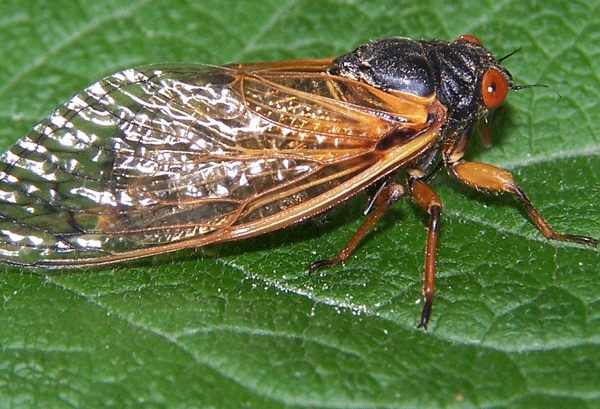April 12, 2011

I recently received an e-mail from a relatively new blueberry grower in Tennessee which asked an intriguing question: "...Tennessee is expecting the 13-year cicadas in a couple of months. We planted our first planting of blueberries in the spring of last year (2010) so they are coming into their second year of growth. Will the cicadas damage them and if so is there anything preventative we can do?"
This summer, much of the eastern United States will experience the emergence of Brood XIX (also known as "The Great Southern Brood"), the 19th Brood for this population of 13-year periodic cicadas.
Cicada adults are large, stout insects that feed on plant xylem. Immature cicadas (nymphs) live underground and feed on roots. Periodic cicadas, members of the evocatively named genus Magicicada, synchronize their life cycle so that the adults all emerge together over a short period of time. This adaptation is presumed to be a defense against predation by overwhelming possibly predators.
In addition to the 13-year cicadas that will be emerging in 2011, there are also 17-year periodic cicadas and many non-periodic cicadas that do not synchronize their emergence. There are also non-periodic species of cicadas, often called "dog day" cicadas because the adults emerge during the hottest part of the summer.
First answer
Cicadas may potentially damage blueberries and other woody perennials such as grapes. Young plants, such as the recently-planted blueberries at our Tennessee grower's farm are likely at greater risk than established plantings. Strawberries are not at risk of cicada injury because they only lay eggs in woody perennials.
Of course, for periodic cicadas to damage plants, they need to present in large numbers. While Brood XIX is expected to emerge over a wide area of the Southeastern United States, mass emergence will not occur everywhere. A map of where Brood XIX is expected to emerge is at http://www.cicadamania.com/pictures/main.php?g2_itemId=3641, and check also http://www.cicadamania.com/where.html.
Chances are good that you will experience Brood XIX this summer if periodic cicadas emerged in your area 13 years ago, and you are in the zone where they are expected. Cicada Mania is an excellent online compendium of all things cicada-related. Adult cicada emergence begins when soil temperatures reach 64 F. For those of you without soil probes, Cicada Mania has posted an emergence calculator based on air temperature.
Damage usually minimal
Damage to plants from adult cicada feeding is typically minimal, even for large, periodic emergences. Of greater concern is the damage that females cause through egg laying. Adult cicadas lay their eggs in woody tissue, under the bark. From the outside, these oviposition scars look like ragged cuts.
Second part of question is a bit trickier
Preventative treatments may be tempting, and soil treatments of insecticides have shown promise in reducing the number of egg laying attempts by female cicadas. However, preventative treatments must be made before insects are present. This means that they may not end up being beneficial if large numbers of cicadas do not appear. Some foliar insecticides may also repel adult cicadas.
For small plantings, netting is very effective at reducing or eliminating egg laying. In locations with young plantings a high likelihood of emergence, preventative treatment may be a good choice. For specific recommendations, contact your county cooperative Extension agent. Find your local Extension resources here at http://www.extension.org/.
You May Also Like




